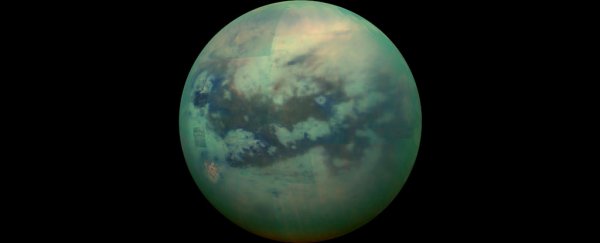Scientists think they might have solved a longstanding mystery about the towering sand dunes of Titan - Saturn's largest moon - and the answer serves as a remarkable reminder of just how different the terrain on alien worlds can be.
Titan's dunes stand up to 100 metres (almost 300 feet) high, but while the prevailing winds on Titan blow from east to west across the moon's surface, the dunes are shaped as if they're blown from the west. Now, researchers think they know why: the dunes could be made up of electrified sand particles, which clump together like some kind of gritty alien Play-Doh.
"If you grabbed piles of grains and built a sand castle on Titan, it would perhaps stay together for weeks due to their electrostatic properties," says geophysicist Josef Dufek from Georgia Tech.
"Any spacecraft that lands in regions of granular material on Titan is going to have a tough time staying clean. Think of putting a cat in a box of packing peanuts."
Scientists have been trying to explain how Titan's sand dunes seem to lean into the wind for years, with most researchers focusing on rogue alien winds sculpting the formations, possibly attributable to violent methane storms raging in the moon's atmosphere.
Dufek and his team took a different approach, hypothesising that the primary reason for the dune paradox might be not be wind activity – but the chemical makeup of the sand itself, and how it behaves when the wind blows.
Unlike sand on Earth, which is mostly composed of silica (silicon dioxide), the sand particles on Titan are thought to be granules of solid water ice coated with hydrocarbons that fall from the atmosphere.
To see how hydrocarbon-rich particles like this might flow under the conditions found on Titan, the team experimented with grains of naphthalene and biphenyl - two compounds that scientists think exist on the moon.
They placed these into a pressurised, rotating cylinder full of nitrogen, designed to emulate the moon's atmosphere, and the friction generated by its wind-flow.
They measured the electric properties of each grain to see if the tumbling session had generated enough static electricity through friction for the particles to clump - this hypothetically could help them resist moderate winds on Titan's surface.
"All of the particles charged well, and about 2 to 5 percent didn't come out of the tumbler. They clung to the inside and stuck together," says one of the team, Josh Méndez Harper.
"When we did the same experiment with sand and volcanic ash using Earth-like conditions, all of it came out. Nothing stuck."
The results suggest that while sand on Earth might not pick up enough electrical charge to become unyielding, the same can't be said for Titan's own grit.
Through the process of regular wind movements, this sand could generate enough frictional charge to become sticky - and for potentially long periods of time.
"These non-silicate, granular materials can hold their electrostatic charges for days, weeks, or months at a time under low-gravity conditions," says one of the researchers, George McDonald.
If the researchers' hypothesis is correct, it doesn't mean that wind flow can't shape the moon's firm dunes - just that powerful air movements would be required to blow the sand in the same direction.
"These electrostatic forces increase frictional thresholds," says Méndez Harper.
"This makes the grains so sticky and cohesive that only heavy winds can move them. The prevailing winds aren't strong enough to shape the dunes."
It may be some time before scientists get a chance to investigate the team's findings on Titan's surface - we might not get a chance until scientists have another opportunity to observe Titan up close - but studies like this can only help other researchers prepare for such a voyage.
Because one thing's for sure: this moon might look like Earth in a lot of ways, but it's really on a whole other level.
"Titan's extreme physical environment requires scientists to think differently about what we've learned of Earth's granular dynamics," says Dufek.
"Landforms are influenced by forces that aren't intuitive to us because those forces aren't so important on Earth. Titan is a strange, electrostatically sticky world."
The findings are reported in Nature Geoscience.
